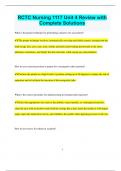RCTC Nursing 1117 Unit 4 Review with
Complete Solutions
What is the proper technique for performing a head-to-toe assessment?
✔✔The proper technique involves systematically assessing each body system, starting from the
head (scalp, face, eyes, ears, nose, mouth, and neck) and working downwards to the chest,
abdomen, extremities, and finally the skin and nails, while noting any abnormalities.
How do you correctly position a patient for a nasogastric tube insertion?
✔✔Position the patient in a high Fowler’s position (sitting up at 90 degrees) to reduce the risk of
aspiration and to facilitate the insertion of the nasogastric tube.
What is the correct procedure for administering an intramuscular injection?
✔✔Select the appropriate site (such as the deltoid, vastus lateralis, or ventrogluteal muscle),
clean the area with an alcohol swab, hold the syringe like a dart, insert the needle at a 90-degree
angle, inject the medication slowly, and withdraw the needle while applying pressure to the site.
How do you assess for edema in a patient?
1
,✔✔Press your fingers into the skin over a bony prominence (such as the shin) and hold for a few
seconds. If a dent remains after releasing, this indicates the presence of pitting edema, which can
be graded based on depth and duration.
What are the steps for preparing and administering a medication through an IV push?
✔✔Verify the medication and dose, perform hand hygiene, clean the IV port with an alcohol
swab, flush the IV line with saline, administer the medication at the recommended rate, flush the
line again, and monitor the patient for any adverse reactions.
How do you perform a basic wound assessment?
✔✔Inspect the wound for size, depth, color, exudate, and signs of infection, palpate the area
around the wound for tenderness or warmth, and document your findings accurately.
What is the procedure for taking an apical pulse?
✔✔Place the diaphragm of the stethoscope over the apex of the heart (located at the fifth
intercostal space at the midclavicular line), listen for a full minute, and count the number of
heartbeats to determine the pulse rate.
How do you properly assess a patient’s pain level?
2
,✔✔Ask the patient to rate their pain on a scale of 0 to 10, where 0 is no pain and 10 is the worst
pain imaginable, and inquire about the location, quality, duration, and any factors that relieve or
worsen the pain.
What are the key steps in assisting a patient with ambulation?
✔✔Ensure the patient is wearing non-slip footwear, use a gait belt if necessary, stand on the
patient’s weaker side, support them as they rise from a seated position, and encourage slow,
steady steps while providing assistance as needed.
How do you perform hand hygiene properly in a clinical setting?
✔✔Wet hands with clean water, apply soap, lather all surfaces of the hands, scrub for at least 20
seconds, rinse thoroughly under running water, and dry with a clean towel or air dry.
What is the correct technique for auscultating lung sounds?
✔✔Using a stethoscope, listen to the patient’s lung sounds by placing the diaphragm on the chest
and back in a systematic pattern, including the upper, middle, and lower lobes, while instructing
the patient to take deep breaths.
How do you conduct a focused cardiac assessment?
3
, ✔✔Assess heart rate and rhythm by auscultating the heart sounds at the four key auscultatory
areas (aortic, pulmonic, tricuspid, and mitral), palpate for any abnormal pulses, and check for
jugular vein distention or peripheral edema.
What is the process for conducting a neurological assessment using the Glasgow Coma Scale
(GCS)?
✔✔Evaluate the patient’s eye opening, verbal response, and motor response, scoring each
component on a scale, and then summing the scores to determine the patient’s level of
consciousness.
How do you prepare a patient for surgery?
✔✔Verify the patient’s identity and surgical procedure, ensure informed consent is signed,
perform a preoperative assessment (including vital signs, allergies, and lab results), instruct the
patient on pre-surgery fasting, and assist with pre-surgery preparations such as skin cleansing or
marking the surgical site.
What are the steps to properly measure and document a patient’s intake and output (I&O)?
✔✔Measure and record all fluids the patient consumes (oral, IV fluids, tube feedings) and all
fluids they excrete (urine, vomit, drainage), ensuring to document the amounts accurately in the
patient’s chart to monitor fluid balance.
4




